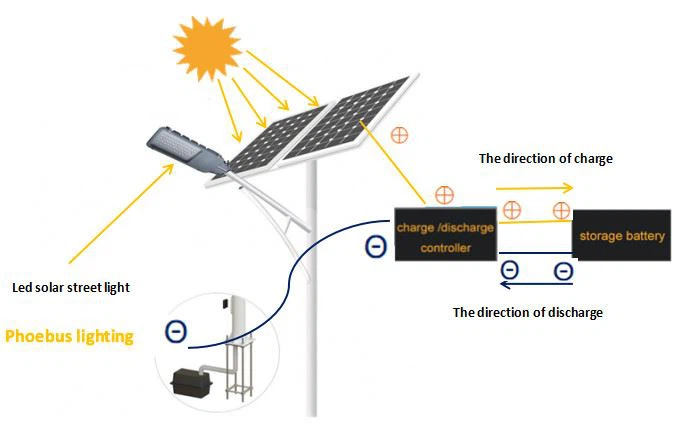Will street lights charge solar panels? In fact, street lights themselves do not directly “charge” solar panels; rather, solar panels absorb sunlight during the day and convert it into electrical energy, which is stored in batteries. At night, these batteries then provide power for the street lights. Specifically:
The Mechanism of Solar Panels
Solar panels convert sunlight into electrical energy through the photovoltaic effect. This conversion occurs during the day when sunlight strikes the panels.
Solar panels are typically installed on the top of street lights or integrated into the lampposts to maximize sunlight exposure.

Battery Charge and Discharge Management
The electrical energy generated by the solar panels is stored in a rechargeable battery. These batteries can store enough energy during the day for use at night.
Modern solar street light designs often utilize wireless technology and fuzzy control theory to manage the charge and discharge processes of the batteries, ensuring efficient utilization and extending their lifespan.
Different Types of Solar Street Lights
Standalone Solar Street Lights:
Each light has its own solar panel and battery, operating independently and not reliant on the grid.
Centralized Power Solar Street Lights:
Multiple solar panels are installed in a central location to form a concentrated power source, which is then distributed via cables to power several street lights. This approach can reduce installation costs for each light but increases system complexity.
Considerations in Practical Applications
Environmental Impact:
The location of the street light and surrounding environment (such as trees and buildings) can affect the sunlight exposure of the solar panels. For instance, if a solar panel is shaded by trees, its power generation efficiency will significantly decrease.
Weather Conditions:
During prolonged rainy or cloudy periods, the power generation capacity of solar panels may be insufficient, requiring batteries to have enough capacity to maintain normal operation of the street lights.
Battery Types:
Common battery types include sealed lead-acid batteries and lithium iron phosphate batteries. Sealed lead-acid batteries are cost-effective and stable in performance but larger in size, making them suitable for underground installation. Lithium iron phosphate batteries have high conversion efficiency and long lifespan, making them suitable for pole-mounted installation.
Advantages
Independence from the Grid:
Solar street lights operate independently from the urban power grid, reducing operational costs, especially in remote areas where the grid is inaccessible.
Environmental Friendliness:
Solar energy is a clean and renewable resource. Using solar street lights helps reduce carbon emissions and aligns with the concept of sustainable development.
Low Maintenance Costs:
Since solar street lights do not require complex cabling, maintenance costs are relatively low.
In summary, solar street lights absorb sunlight through solar panels during the day, convert it into electrical energy, store it in batteries, and use that energy to power the lights at night, thus achieving the goals of energy conservation and environmental protection.
Solar Street Light Height and Distance Spacing Calculation
Understanding Solar Street Light Color Temperature (CCT): Kelvin
What is Lux in Lighting? Solar Street Lighting Lux Level standard
What is Light Uniformity? How to Calculate Lighting Uniformity
Lumens vs watts: lumens to watts conversion chart
Understanding the Luminous efficacy of Solar Street Lights
Solar Street Light Tilt Angle Installation: A Comprehensive Guide
Color Rendering Index (CRI) in Solar Street Lights
Solar Street Lights Battery Comprehensive guide
Guide to Selecting Solar Street Light Poles
Solar Street Lights Design Guide: Key Calculations and Considerations